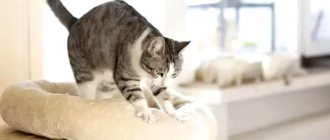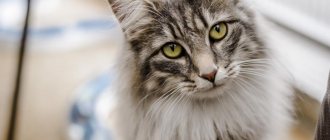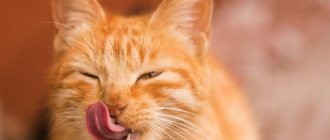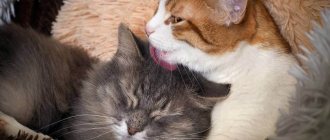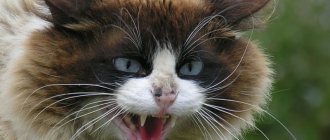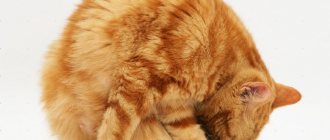Mechanism of sound occurrence
Why are the mechanics of a cat's purr still so poorly understood? The fact is that it is possible to determine for certain what and how cats purr only by dissection. But, of course, the dead don’t sing any “songs.” And modern diagnostic methods do not allow us to determine the origin of sounds.
It is known that there is no special organ for chirping sounds. This process definitely involves the vocal cords, the lungs, since “mur” sounds rhythmically, on inhalation and exhalation, and, possibly, the diaphragmatic and intercostal muscles. And - absolutely - the brain.
A cat's purring is a complex process that involves the lungs, muscles and brain.
Most researchers believe that cats purr through their throats. The vocal cords contract and the sound passing through them vibrates with each inhalation and exhalation. But what makes a cat do this? Question for neurophysiology. The “motor” is started by a mechanism in the brain.
Interesting fact: the comparison of a purring cat with a tractor is not accidental. At idle the car produces the same 15–150 Hz. Owners note that female cats purr louder than male cats.
There are alternative theories of the origin of uterine sounds:
- This is the sound of blood moving through the inferior vena cava, which carries venous blood to the heart.
- This is what the hyoid bones do.
- There are false vocal cords that are responsible only for these sounds.
- It was previously believed that vibrating sounds originated from the abdomen. But anyone who has petted a cat knows that this is not the case.
For now, the neurophysiological theory prevails: the need to vocalize breathing arises in the brain, and it already gives the command to the vocal cords. We hope that scientists will soon test the hypothesis and the age-old mystery will be revealed. In the meantime, let's figure out what causes the cat's brain to signal to the ligaments.
Most often, cats purr in a relaxed state, for example, on the owner's lap.
How do cats manage to purr?
There is still no one hundred percent answer to the questions: why cats purr loudly and how they do it.
However, there are several hypotheses regarding the origin of the rumbling process, which are accepted by scientists as possible. The most plausible theory is the presence of a hyoid bone .
Hyoid bone
According to recent research, rumbling occurs due to the presence of a hyoid bone in cats. Rumbling occurs in connection with the emotions experienced by the cat, which provoke the entry of a nerve impulse into the larynx, and it begins to shrink. This sets the said bone in motion when the cat breathes.
This theory is considered the most reliable, since rumbling is not observed in cats with laryngeal paralysis. Moreover, the type of rumbling depends on the shape of this bone.
Thus, domestic cats produce vibrating and pleasant sounds. The purring of a domestic cat is used in some areas of medicine to calm the nervous system and prepare the human body for heavy stress.
In cats, the bone has a triangular shape. In larger predators, for example, lions, the hyoid bone has the shape of a rectangle , which is why the rumbling sound is rougher, bassier and growling.
Lungs and diaphragm
Another theory is the work of the muscles of the diaphragm and ribs . When breathing, sound vibrations of different amplitudes are created. However, this theory can hardly be called reliable, since the intensity of purring in this case would have to change, which does not happen in real conditions.
False ligaments
Another theory is based on the work of the false cords, which are located directly above the vocal cords. According to the theory, rumbling occurs due to changes in pressure in the circulating bloodstream . Thus, vibration occurs in the chest and sound is transmitted to the sinuses.
What does a cat's purring mean?
Previously, it was believed that this is how animals communicate with each other and humans when they are stroked. However, “mur-mur-mur” is not only a means of communication and a way to express pleasure.
Method of communication
Kittens begin to purr already in the first days after birth. This is how they help mom find herself and feed her. With a person, everything works about the same. Animals wake people up, butt and purr loudly in the morning, especially if they spend the night in another room. “Good morning, master! It’s time to get up and feed me.” If your pet loudly “sings songs” in the kitchen (or where you usually feed your pet) and curls under your feet, meowing periodically, this is a direct hint of a desire to snack.
Surely you have noticed more than once that pets greet you stormily from work. At this moment, you can also hear a joyful “mrrr”.
Purring, the cat greets its human.
In relation to relatives, everything works exactly the same: a quiet sound indicates location. He warns others about a benevolent and good-natured attitude. This is also how animals encourage each other. Some scientists have noticed that wounded cats lie down next to each other.
Expression of pleasure
A satisfied cat - what could be more pleasant for the owner? Pets can actually express pleasure and even gratitude from tasty food, a secluded bed and warmth. Many pets love affection, and with the help of purring they express pleasure from stroking and scratching.
In combination with paw stomping, purring indicates peace and love. This means that your pet completely trusts you, is happy and feels as calm as she does next to her mother. After all, kittens’ little paws make “massage” movements to get more milk. Apparently, the memory remains with the animal forever, and pops up in moments of good mood. And besides, in this way the cat “marks” the owner.
Connection with nutrition
Remember that a kitten purrs so that the cat notices and feeds it? Echoes of this mechanism can be seen in the fact that many animals rumble when they eat. Perhaps from pleasure. Especially if it is SUPERPET - a species-typical food for cats and dogs according to the BARF system, developed by veterinarians and nutritionists. It replicates the diet of predators in nature: 98% consists of raw meat without heat treatment, flavor enhancers and preservatives. Biologically appropriate nutrition normalizes digestion, prevents urolithiasis, kidney disease and other ailments. And how delicious it is! Pets can only purr with pleasure.
Cats purr when they fall asleep
Every animal lover could observe the process of a cat falling asleep with its own musical accompaniment, but not all people know that cats communicate with each other using purring. There is a stereotype that only people and dolphins consciously talk to each other. But that's not true. Cats talk to each other quite often. But they do it quietly. They only swear loudly. Expressing aggression, cats growl and meow loudly. But when they are friendly, animals do not use their voice. In a calm, peaceful environment, cats purr. For example, when a cat feeds kittens, she purrs, and the kittens purr back to her.
Food for adult cats and kittens
Start shopping
Stress and pain
Cats begin to make purring sounds in different situations. It can be very stressful - right after having to run away from the dog. Or weak - when examining a new room. By purring, pets calm not only humans, but also themselves. Rhythmic sounds are a great way to relax.
There is a hypothesis that purring animals heal themselves. Vibration frequency from 20 to 150 Hz helps restore tissue, including bone, grow muscles, repair tendons and ease breathing. In their natural environment, animals have to sit in ambush for a long time when hunting and jump quickly, so it is important to maintain bone tissue in order.
Felines often purr when they fall asleep. It is possible that a large amount of sleep is also associated with the restoration of the body - up to 20 hours a day.
Loud purring for no apparent reason can be a signal to the owner that the cat is in pain. Especially if she sits with her eyes closed and her mustache drooping. Be careful: these animals endure pain until the last moment and hide their symptoms.
If a cat purrs in a tense position without closing its eyes, it is unlikely that it is feeling well at that moment.
During childbirth, cats also purr, helping themselves to overcome pain. Unfortunately, even before death, many of them make such sounds. Purring is very connected with physiological processes: appearing in the first days of life, it remains with the cat until the very last moments.
It is important to note that all cats are different, and they also vocalize their emotions differently. Some of them do not purr at all, while others trill constantly. And all these are variants of the norm. You can understand what your pet wants at the moment by her body language. A relaxed posture indicates pleasure, a tense one indicates that she wants something from you. An excited purr near a bowl is very different from what you hear when a furry dog curls up next to you.
When she gets what she wants, the purring stops. Think about the situations in which this happens and what the animal wants to tell you. Develop your powers of observation and you will be able to better understand your four-legged companion.
Why do cats purr?
The issue of cats purring is much more complex and deeper than it seems at first glance. Understanding why your pet purrs will be a big step towards predicting his mood, meeting his needs and, above all, living a harmonious life with him. Below are some of the reasons why cats purr.
Reason #1: Purring as a means of communication
Cats communicate primarily through movement, but that doesn't mean they can't communicate through sounds. However, unlike humans, whose speech has evolved over many years, cats have to make do with just a few sounds they can produce - and purring is one of them.
One of the reasons your pet purrs is communication.
Did you know that cats can make many different purring sounds? For example, if your pet purrs due to hunger, then the purring is accompanied by a whimper, similar to the cry of a child. Sounds like these are hard to ignore
The idea is to appeal to the parental instinct in you and draw attention to the hungry animal
Reason #2: the bond between a mother and her kittens
A nursing mother is known to purr to communicate with her kittens. She uses purring as a lullaby to calm babies. This works much the same way as rocking or humming for babies.
Babies communicate with their mother by purring
Kittens begin to purr a few days after birth. At this time, their auditory and visual abilities are not yet fully functional. For young kittens, purring is a way of reassuring their mother that they are okay. Babies also purr to call out to their mother when they feel she is not around.
Reason #3: Manifesting Happiness and Satisfaction
A cat purrs when it is happy and content. This is due to her good health and satiety. A cat will purr while eating, and kittens will purr when their mother licks them. Tickling or a light massage also makes cats purr with pleasure.
A cat purrs when it is happy and content
These manifestations of feline pleasure can make us, their owners, happier. Cat purring is in the frequency range that relaxes people. It has been scientifically proven that cat caresses and purring vibrations have a calming effect on humans. Reducing tension correspondingly lowers blood pressure levels. This explains the benefits of cat companionship for your health.
Reason #4: Pain relief
Do you think cats only purr when they are happy and healthy? It is not always so. You should not ignore the signals that your pet gives, because the cause of purring may be illness. Purring can also be caused by your cat trying to relieve your pain.
Cats purr when they seek relief from pain.
- Cats tend to purr during labor. Purring triggers the release of endorphins in the animal's brain centers. This “happy hormone” acts as a powerful natural pain reliever and helps her relax. Purring is also an alternative to the agonizing screams that would attract predators in the wild.
- In addition, cats can purr in a range that helps speed up the healing of fractures and torn ligaments. These frequencies can also soothe sore muscles. The need for such skills is due to the fact that these animals sleep on average 16 hours a day. This prolonged inactivity contributes to decreased bone density and muscle strength. Seals counteract these processes by purring. This can also speed up a person’s healing. The purring frequencies are believed to be in the same range as the frequencies used in ultrasound devices to speed the healing of bone fractures in humans.
- If you have trouble breathing, try to breathe in sync with your cat's purring. The purring process imitates the normal dynamics of human breathing - thus the cat helps restore the normal rhythm of inhalation and exhalation.
However, don't try to imitate your cat's purring. If you have tried this before, then you must have already realized that it is impossible. You probably experienced shortness of breath after the first few seconds of trying in vain. The question arises: how do cats do this?
Do big cats purr?
We have said more than once that the anatomy of a domestic cat is no different from the structure of a wild one. From a structural point of view, the gastrointestinal tract has not changed over millennia of evolution. What about neurophysiology and psychology?
Small cats - caracals, lynxes, cheetahs - purr like our domesticated pets. Although, of course, more often they hiss. Leopards, lions, panthers and tigers do not purr in the usual sense - they rather roar and make bass sounds. Their purr is more like a roar. But predators definitely use these techniques to communicate, when consuming food and expressing pleasure. There are videos online of cheetahs, tigers and pumas purring.
Can all cat species purr?
Only small breeds of cats can purr. Their large ones cannot seem to do this because of the different structure of the laryngeal apparatus. The vibration that passes through the animal’s body passes through the hyoid bones before acquiring “musical accompaniment”. And this apparatus is quite mobile in domestic cats. Therefore the vibration is converted into sound. In wild feline animals, such as lions or tigers, the hyoid bones are immobile. After all, they are designed to chew tougher food, and as a result, they need a more powerful jaw.
Why your cat doesn't purr and what to do about it
Is it possible to make a cat purr? No, especially if she is not naturally inclined to do this. And that's okay: not everyone feels the need to express emotions by purring. There are even breeds that are not inclined to turn on their “engines” - Ragdolls and Devon Rex. Here, again, there are exceptions.
Getting a purr to do anything is very difficult in general, and with purring and other ways of expressing emotions it is even more difficult. This partly explains the impossibility of accurately diagnosing the mechanics of the appearance of iridescent sounds in predators. Nobody wants to purr in an MRI machine or during an ultrasound.
Sometimes this “insensitivity” is related to previous negative experiences. If the cat has been with bad owners or on the street, it may simply be afraid to show emotions by purring. You can try to help your cat make the desired sounds. Play with her, caress her, introduce treats into her diet (always natural) and demonstrate by your behavior that you are a safe person.
How do cats purr?
We are able to observe the purring, understand the reasons and reasons for its occurrence. But what can we say about the mechanism for producing these purring sounds? Oddly enough, it has not been fully studied by scientists.
What is clear is that a special organ that would produce such sounds was not found in cats. Otherwise, instead of a clear answer, we are offered a number of scientifically based assumptions/theories:
- The purring is caused by the vibration of the cat's lungs.
- Occurs when there is a change in blood movement/circulation in the cat’s body.
- In recent studies, the purring mechanism is described as a sequence: “the appearance of electrical impulses in the cat’s cerebral cortex - the vocal cords receive these impulses - contraction of the muscles associated with them.”
How does the mechanism for producing purring sounds work?
The “purring apparatus” itself is a thinly connected hyoid bone, which is located between the base of the skull and the base of the tongue. But it is the contraction of the muscles near the vocal cords that causes them to vibrate, and, accordingly, the appearance of purring sounds.
At the same time, the cat’s mouth and nose participate in their reproduction, while the vibration spreads throughout its entire body. One of the features of purring is the inability to listen to the cat’s heartbeat and monitor its breathing.
If necessary, to stop the sounds of purring, it is recommended to turn on the water from the tap - while it flows, the cat stops purring.
The benefits of a cat's purring for humans
Our smaller furry brothers are real doctors. There is even feline therapy - treatment by communicating with cats. Pet owners cope better with stress, are less likely to become depressed, are more sociable and, in general, are healthier than people without pets. Why is purring useful?
Cats are furry physiotherapists. At a frequency of 25-50 Hz, bone tissue responds to purring, and at 100 Hz, skin and soft tissues respond. It's not as crazy as it may seem: the body's tissues respond to pressure by becoming stronger. Scientists even propose using this property of vibration for astronauts so that their bones do not lose their density in zero gravity.
A purring cat pleases the human heart. This means that having a pet in the home reduces the likelihood of having a stroke by a third. “Pur-mur-mur” is a kind of white noise, to which the owner calms down and falls asleep more easily.
Thus, not all purring kittens and cats are happy with their situation. A purring pet can feel both joy and pain. This amazing means of communication allows animals to communicate with each other and get what they want from humans. If a cat likes food or, conversely, is hungry, it will purr. This is done by domestic purrs, cheetahs, and pumas. But if your pet does not want to purr, this is also not a problem, and you can do nothing about it.
Author of the article
Yulia Antonovskaya
Lyricist
Rate this article
- 5
- 4
- 3
- 2
- 1
0
votes, average:
0 out of 5
Cat massage
There are many guesses why the pet purrs and tramples its owner with its paws. Here are some of them:
Memories of childhood, or “milk step” - kittens knead their mother with their paws while feeding to quickly obtain milk. This brings them pleasure and is associated in adults with a feeling of comfort, satiety and security.
Prepares a comfortable place to sleep - tramples the surface on which you are going to sleep for the greatest comfort. The owner's knees may well be suitable for this purpose.
Gratitude - in this way one can say “thank you” for delicious food, warm shelter, tenderness and affection.
Therapeutic massage is a common theory that this is how a cat treats its owner from ailments.
Stress relief – by purring and moving their paws, cats lift their spirits, relax and calm down.
Unfulfilled sexual instinct - one theory says that if an animal does not have a mate, it may show unambiguous interest.
Marks its property - cats have glands on their paw pads that secrete a secretion. This is one of the ways to convey to other animals that a person belongs to him.
Showing trust and love - the pet shows its owner its location, favor, openness and trust. Emphasizes your closeness with a person.
This massage soothes, relaxes and helps relieve stress. But what if claws are used? You can lightly press the cat towards you so that he lies down and stops trampling. You should not scold or drive out an animal if its trust and peace of mind are valuable. It’s better to just put a blanket or pillow on your knees in advance.
For what reasons does a cat purr?
When answering why cats purr, many owners confidently say that the reason lies in positive emotions. This answer is correct, but incomplete. Sometimes purring is also triggered by negative emotions. You can only understand your pet's desires over time by remembering the difference in volume, duration and frequency of sounds.
Positive emotions
The ability to make a vibrating sound appears in kittens on the 2nd day after birth.
This is necessary to communicate with the mother. The purring of the babies indicates their satiety and good health, and the sounds emanating from the mother cat confirm the safety of her offspring.
In the wild, light vibrations are not detected by other predators, but are clearly perceptible to parents located at a long distance. This helps protect the litter until it becomes independent.
Among the positive emotions that awaken purring are:
- greeting the owner or communicating with other animals;
- going to bed before bed;
- gratitude for the treat or affection received;
- attracting the opposite sex;
- trying to beg for something tasty;
- interest in some object (delicious food) or object (a bird outside the window).
According to one version, cats purr to prevent muscle diseases that threaten them due to too much sleep. Vibrations spreading throughout the body have a positive effect on ligaments, bones and muscles, helping to reduce the load on the musculoskeletal system.
Negative emotions
Purring also occurs when a furry pet is under stress. The vibrations help him stabilize his blood pressure and bring his pulse back to normal.
Sometimes the reason lies in illness. Purring is a physiological pain reliever. It speeds up metabolism and promotes rapid regeneration. Try to observe how a cat purrs after sterilization: the frequency and volume of the sound will differ from usual until the end of rehabilitation.
One of the possible complications of coronavirus infection is feline infectious peritonitis. Its alternative name is “purring disease.” Due to damage to the blood vessels, some of the fluid enters the peritoneum and lungs, causing peritonitis. The bloating that appears is accompanied by a characteristic purring sound.
Also, mustachioed pets purr when their owner strokes them incorrectly or when a more formidable opponent tries to scare them. In the second case, they demonstrate their defenselessness, trying to avoid a possible fight.
Interesting
There is an opinion that when cats purr, they can alleviate the condition of people during diseases such as depression, hypertension, and angina.
While the animal is purring, it is impossible to listen to either the heart or lungs. To stop the sound, veterinarians are forced to turn on the water and listen to the pet’s condition.
If a cat purrs loudly, then he is happy with life. When he says it quietly, he thereby attracts attention to himself, as if the pet is making a request.
A person, imitating a cat's "mur", does not copy tailed pets; at this time they pronounce the sounds: r, f, x, v, n, o, a, i, y, e.
Purring expresses more than just happiness
Some cats purr when they are excited or nervous. It happens that a purr scratches its beloved owner if he misunderstands the cat’s emotional state.
It happens that a cat purrs at a veterinarian's appointment. This is how he shows his dependence and consoles himself as best he can.
Observe all signs of the cat’s psychological and emotional state:
Position of ears and tail. Follow his gaze. Pay attention to your general body position.
If he's lounging on his back, paws up, eyes closed and purring at full volume, rest assured, he's happily demonstrating his complete satisfaction with life.
The owner must learn not only to enjoy the singing of his cat, but also to understand why he purrs:
- Wants to say something.
- Show your mood.
- Give a sign that there is a problem.
- Report the onset of illness.
